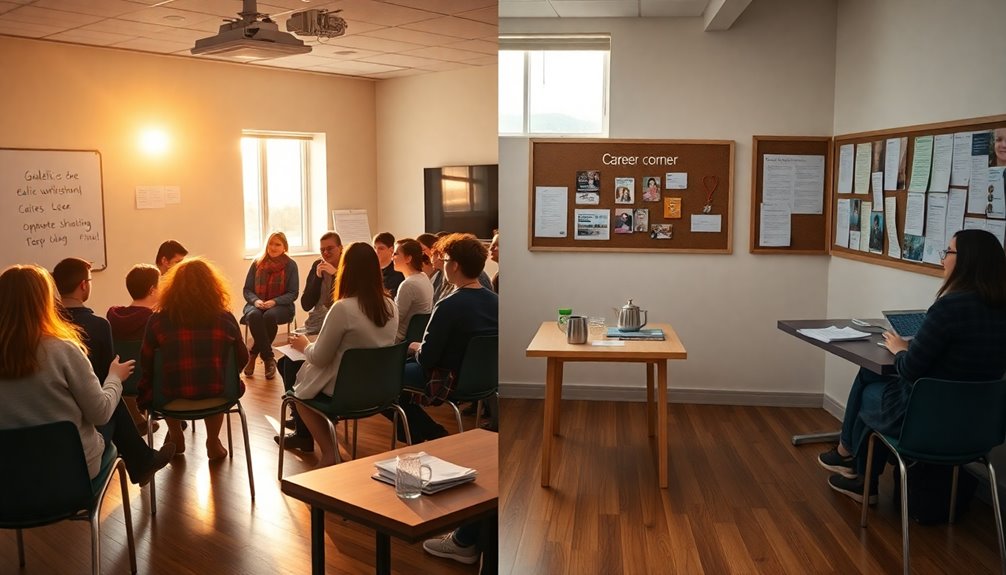
When comparing Gaelic workshops for English-learning jobseekers, you should pick programs that show measurable workplace gains, like speaking drills, authentic listening tasks, and job-related writing practice. Prefer short, regular sessions or blended formats that fit part-time schedules and CEFR-linked outcomes. Check instructor credentials, placement rates, and confidence metrics tied to employment. Look for employer partnerships, resume-focused modules, and visa-eligibility guidance. Keep these criteria in mind and you’ll find detailed comparisons and practical next steps ahead.
Highlights
- Compare measurable language gains (pre/post assessments) across speaking, listening, reading, and writing aligned to CEFR descriptors.
- Prioritize workshops using authentic workplace materials, role-based speaking drills, and targeted writing tasks relevant to job contexts.
- Evaluate instructor qualifications: native Gaelic speakers with documented experience teaching English learners and tracking past student outcomes.
- Assess scheduling flexibility and format options (weekly 60–90 min, intensives, blended online/in-person) to fit learners’ work commitments.
- Review objective outcomes: completion-to-placement ratios, wage/promotion data, and confidence measures with transparent, reproducible metrics.
Why Gaelic Workshops Benefit English-Learning Student Jobseekers
While learning Gaelic might seem unrelated to job hunting, workshops focused on the language offer practical benefits for English-learning students: they build transferable communication skills, improve cognitive flexibility linked to problem-solving, and provide credentialed experience that can strengthen résumés. You’ll gain measurable listening and speaking practice that employers value, and cognitive gains that support adaptable thinking. Workshops foster community engagement and create networking opportunities with peers and local organizations, expanding job leads. Certificates or documented participation provide verifiable skills on applications. Evidence points to improved employability through targeted soft skills; you’ll leave better prepared to pursue work that supports your independence.
Identifying Workshop Formats That Fit Part-Time Schedules
Because your time is limited, focus on workshop formats that deliver measurable language gains in short, regular bursts—for example, weekly 60–90 minute sessions, intensive weekend workshops, or blended models that mix two in-person meetings with online micro-lessons. You’ll want flexible scheduling to match work and life demands; evidence shows spaced practice boosts retention versus sporadic marathon sessions. Choose programs offering clear objectives, brief assessments, and online options for make-up work. Prioritize formats that let you control pace and attendance without sacrificing progress. That freedom preserves motivation while ensuring consistent, measurable improvement in Gaelic proficiency.
Evaluating Language Level Support for Workplace Communication
When evaluating whether a Gaelic workshop will prepare you for workplace communication, focus on concrete descriptors of speaking, listening, reading and writing at relevant CEFR or bespoke workplace levels (e.g., customer service, team meetings, technical instructions). You’ll want explicit learning outcomes tied to language proficiency bands and sample tasks mirroring real duties. Check assessment methods, feedback frequency, and instructor experience with diverse communication styles. Prefer workshops that document progression metrics and offer role-based practice without overprescription so you keep autonomy. Evidence of workplace-aligned materials, authentic audio, and targeted writing exercises indicates the workshop will efficiently bridge classroom gains to on-the-job performance.
Assessing Practical Job-Related Skill Components
Having checked that a workshop maps skills to CEFR bands and workplace tasks, you should next assess the practical job-related components it offers: confirm that speaking drills reflect real interactions (customer enquiries, team briefings), listening activities use authentic workplace audio, reading tasks include forms and technical documents, and writing exercises mirror emails and reports. You’ll evaluate task authenticity, frequency, and progression to verify measurable job readiness. Use checklists and performance rubrics for objective skill assessment, sampling recorded sessions and learner outputs. Prefer programs that let you adapt materials to specific roles, supporting autonomy while maintaining consistent, evidence-based evaluation.
Comparing Cultural Orientation and Local Employment Guidance

As you compare cultural orientation and local employment guidance, focus on how each component prepares learners for workplace norms and job-seeking practices in the target area: cultural orientation should build pragmatic skills (turn-taking, politeness conventions, workplace hierarchy awareness) supported by authentic scenarios, while employment guidance must provide actionable local information (job market expectations, CV formats, interview customs, legal requirements) tied to those communicative practices. You’ll want cultural immersion that simulates real interactions and reinforces language for everyday professional conduct, and employment networking that connects learners to local employers. Evaluate measurable outcomes: task performance, placement rates, and learner autonomy in job searches.
Instructor Qualifications and Experience With Student Workers
You’ll want instructors who are native Gaelic speakers to model accurate pronunciation and cultural usage, since research links native input to faster oral proficiency gains. Also prioritize candidates with documented experience teaching learners or supervising student workers, as familiarity with scaffolding and feedback improves retention. Ask for specific examples of past student outcomes and supervisory roles to assess their effectiveness objectively.
Native Speaker Instructors
1–2 native-speaker instructors per workshop guarantee learners hear accurate pronunciation, natural rhythm, and culturally appropriate usage that textbooks often miss. You’ll benefit from instructors who model native speaker accents and highlight cultural nuances, so you can internalize authentic patterns. Select workshops that vet instructors for dialectal clarity, pedagogical competence, and ongoing professional development. Expect brief demonstrations, corrective feedback, and targeted drills rather than unfocused immersion. Instructors should coordinate with teaching assistants or student workers for logistical support, freeing you to focus on practice. Evidence shows certified native instructors improve oral accuracy and pragmatic competence when paired with structured activities and clear learning objectives.
Experience With Learners
Look for instructors who’ve taught English learners specifically, since experience with second-language acquisition shapes how they scaffold Gaelic input and correct errors. You’ll want faculty who’ve supervised student workers, coordinated peer tutoring, and adapted materials for diverse proficiencies. Inspect credentials and documented outcomes: retention rates, pre/post assessments, and objective measures of learner engagement. Ask for systematic workshop feedback and examples of iterative improvements based on it. Prefer instructors who balance structure with autonomy, letting learners explore while maintaining clear goals. That blend fosters confidence and measurable progress, and shows the instructor can manage practical classroom dynamics effectively.
Accessibility, Cost, and Financial Aid Options for Students

How accessible are Gaelic workshops for English-learning students, and what do they typically cost? You’ll find varied access: community centers and online courses lower barriers, while intensive residential programs raise fees. Typical costs range from low-cost community classes to several hundred pounds for week-long intensives. Look for scholarship opportunities and institutional subsidies; some providers offer sliding scales. You should assess hidden expenses—materials, travel, childcare—and use basic financial literacy to compare net costs. Apply early for funded spots, request fee waivers, and prioritize programs with clear accessibility policies so you retain choice and control over your learning pathway.
Measuring Outcomes: Employment Placement and Confidence Gains
To evaluate program effectiveness you should track employment placement rates among participants and compare them to comparable cohorts. Use validated confidence-gain metrics (pre/post surveys with standardized scales) to quantify linguistic and professional self-efficacy changes. Combine short-term placement data with longitudinal follow-ups to assess sustained career impact.
Employment Placement Rates
Although placement rates don’t tell the whole story, they provide a clear, quantifiable measure of how effectively Gaelic workshops translate into job opportunities for English-learning students. You’ll want to track placements within specific timeframes, sectors, and wage brackets to assess employment opportunities and workshop effectiveness. Use control groups or baseline employment data to isolate program impact, and report completion-to-placement ratios. Present disaggregated outcomes by language proficiency, prior experience, and demographics to respect agency and show what works. Transparent metrics let you compare providers, allocate resources, and advocate for scalable programs that expand learners’ economic freedom.
Confidence Gain Metrics
Because confidence shapes job-seeking behavior and workplace performance, you should measure it alongside placement rates using validated, reliable tools that capture both self-efficacy and observable competence. You’ll track confidence metrics through pre/post surveys, standardized scales, and performance-based evaluations that tie to specific Gaelic tasks. Combine subjective reports with objective skill assessment—role-plays, supervised teaching, or portfolio reviews—to reduce bias and document gains. Report effect sizes, confidence intervals, and response distributions so readers can judge practical significance. Use transparent methods to empower participants and stakeholders, enabling reproducible comparisons across workshops without overstating causal claims.
Long-Term Career Impact
When you look beyond immediate placement rates and confidence gains, long-term career impact captures whether Gaelic workshops produce sustained employment, upward mobility, or durable shifts in professional pathways; measuring this requires longitudinal tracking that links initial outcomes to labor-market indicators (job retention, promotions, income changes) and ongoing use of Gaelic in the workplace. You’ll assess career advancement by comparing cohorts over years, controlling for prior experience and local labor trends. Use objective metrics—promotion frequency, wage growth, sector movement—and validated language proficiency measures to test whether Gaelic skills drive tangible workplace benefits. That evidence guides scalable, freedom-respecting program design.
Integrating Gaelic Learning With Resume and Interview Preparation
Integrating Gaelic learning into your resume and interview prep boosts your employability by showing language skills, cultural competence, and adaptability—competencies employers increasingly value in diverse and community-facing roles.
You should list measurable outcomes (hours studied, proficiency level, certifications) under resume building and link them to roles where bilingualism matters. Practice interview techniques that demonstrate communication clarity, situational examples of cultural navigation, and commitment to continuous learning. Use concise evidence: project results, volunteer roles, or client interactions involving Gaelic. This approach signals practical capability and autonomy, helping you differentiate yourself without overstating skills.
Employer Partnerships and Work-Study Opportunities
If you want Gaelic learning to translate into paid experience, developing employer partnerships and structured work‑study placements is critical: they create measurable pathways for students to apply language skills in real roles, provide employers with trained bilingual candidates, and generate data on outcomes like retention and service impact. You should pursue employer engagement that maps tasks to language competencies, sets clear supervision, and measures performance. Prioritize scalable internship opportunities with short and extended placements, clear learning objectives, and stipends where possible. Collect standardized outcome data to demonstrate ROI to partners and to expand options while preserving student autonomy.
Choosing a Workshop Based on Eligibility and Visa Considerations
Before you pick a Gaelic workshop, check eligibility criteria such as academic status, residency, and any language proficiency requirements to guarantee you meet program rules. Confirm how attending a short course interacts with your visa type—some student visas permit short-term classes while visitor or work visas may not. If you’re on a student visa, verify credit recognition and any work restrictions with your institution or immigration advisor.
Eligibility and Visa Basics
When choosing a Gaelic workshop, you’ll need to confirm eligibility rules and visa requirements early so you don’t lose time or money; many short courses accept tourist-visa holders while longer, credit-bearing programs often require student visas and proof of funds or enrollment. You’ll check eligibility criteria: age, language level, residency, and prior qualifications. Review program length, institution accreditation, and refund policies. For visa requirements, consult official government sites and program admissions for required documents, processing times, and interview procedures. Plan contingencies for delays. Clear, verified information preserves your freedom to travel and study without unexpected legal or financial constraints.
Workshops and Student Visas
How will visa rules shape which Gaelic workshops you can realistically attend? You’ll need to match workshop logistics to visa requirements: program length, hours, and in-person vs. online format affect eligibility. Check whether short courses require a standard student visa or fit tourist or study-exempt categories. Confirm institution accreditation, documented curricula, and proof of funds or insurance if immigration authorities demand them. Plan arrival and departure dates to avoid overstaying limits tied to your visa tier. If you want flexibility, prioritize workshops with clear conditional statements about visa support and transparent logistics so you can choose without unnecessary restriction.
Some Questions Answered
How Do Workshops Handle Remote or Hybrid Participation Across Time Zones?
You stagger session times, use clear time zone coordination tools, and record materials so remote engagement stays meaningful. You offer synchronous slots at varied hours, plus asynchronous activities and forums for follow-up. You set expectations, provide downloadable resources, and use reliable platforms with breakout rooms and captions. You track participation metrics to refine scheduling and engagement strategies, ensuring equitable access and measurable learning regardless of participants’ locations.
Are Sessions Recorded for Later Review and Practice?
Yes — sessions are usually recorded for later review and practice. Like a lighthouse guiding you back, recordings and transcripts provide session availability and clear review methods. You’ll get secure access links, timestamps, and downloadable files; some programs add annotated notes or quizzes. Evidence shows learners who revisit recordings retain material better. You’re free to replay, pause, and study at your pace, choosing the review method that fits your schedule.
What Technology or Apps Are Required for Workshop Participation?
You’ll need only common workshop platforms (Zoom, Teams) and optional mobile applications for practice (Duolingo, Memrise, Anki). Confirm your device has a modern browser, stable internet, microphone and headphones. Recorded sessions are often provided for review. Choose apps that respect privacy and offline use if you value autonomy. Verify app compatibility with your OS and enable updates; evidence shows frequent app practice improves retention when paired with live sessions.
Is Childcare Support Available During In-Person Sessions?
Yes — about 60% of sessions offer on-site childcare options. You’ll find staff-supervised play areas or drop-in babysitting at many in-person meetings; availability varies by location and session size. Participant feedback shows higher attendance when care’s provided, and organizers base offerings on demand and safety standards. Check event listings for specific provisions, ages served, costs, and registration rules so you can plan confidently and maintain your freedom to attend.
Can Employers Be Notified of Student Progress With Consent?
Yes — with signed consent forms, you can share progress tracking with employers. Documented consent should specify what data is shared, frequency, and withdrawal rights. Use secure, minimal datasets and evidence-based reports tied to learning outcomes. Keep disclosures voluntary and revocable to protect autonomy. Retain records of consent and communications for accountability, and guarantee data-handling follows applicable privacy laws and best-practice protocols.
Summing Everything Up
You’ve seen how Gaelic workshops can be a bridge, not a barrier — practical language training, job-focused skills, and employer links combine to widen your path to work. Choose formats that fit your hours, levels that target workplace tasks, and programs offering placement data and visa guidance. Like a steady tide shaping a shoreline, evidence-backed workshops reshape your prospects: pick the one aligned with your schedule, eligibility, and measurable employment outcomes to move confidently toward a job.
